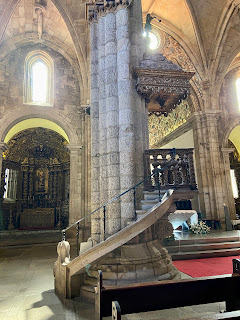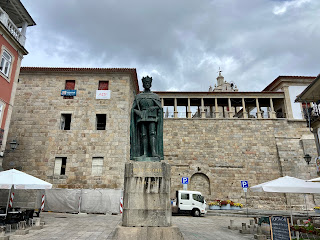Viseu lies west of Linhares and Trancoso, but is historically part of the Beira Alta. With a population about twice of Guarda's (99,551 in 2021), it is one of the largest cities in the area. The Catedral (twelfth to seventeenth centuries) and Claustro house an extensive museum of sacred art. The distinct architectural eras and details are remarkably easy to read: the old bell towers, the Doric central facade, the colonnade of the cloisters, and the various chapels.
By contrast, across the street, the Baroque (eighteenth century) Igreja da Misericódia is a model of consistency.
We expect rain today, so plan a day indoors. First, we try the entrance at the neighboring Museu Nacional Grão Vasco (in the Paço dos Bispos, sixteenth century), named for the great Portuguese Renaissance painter Vasco Fernandes, but it is closed. One of four days that the Museu is closed, today is an obscure municipal holiday (Dia de São Mateus). The Museu renovation (2001 to 2003) is by Eduardo Souto de Moura. We'll have to see it on another visit.
So, we enter the Claustro to explore the Catedral. The architecture appears to be Neo-classical, with a Tuscan colonnade above an Ionic base. There is a marvelous, if slightly stiff-looking Pieta, as well as several beautiful, large azulejos murals.
Inside the Catedral, the eras continue to mix and blend in interesting ways. The Romanesque and Gothic vaults are supported by Manueline ribs and stonework. In places, the masonry is hammered and pock-marked, perhaps to accept a plaster finish that is no longer extant. Saramago's traveller remarks:
And here at last is the cupola of the knots, an extravagance due either to the architect who proposed the idea or to the Bishop who required it: the traveller is not really concerned who was responsible. He is such an admirer of lines justified by necessity that he cannot see the reason for these imitation knots. It is taking the sixteenth-century love of ropes too far to make them into Manueline decoration. The traveller has no doubt that any tourist would be bowled over by them, and he asks of his coat buttons exactly what it is that would bowl the tourist over. As on other occasions, his buttons gave no reply. (José Saramago, “Journey to Portugal,” 1990; trans Hopkinson-Caistor, 2000)
The chapels are Baroque and Rococo, including the capela mor, with its spiral columns and elaborate painted ceiling.
The Sala de Capítulo (twelfth century) lacks the knots but is filled with fascinating details due to the complex vault. It houses the old baptismal font, with a gilded lamb as a handle for the cover.
Upstairs, in the Coro Alto, is the entrance to the Museu de Arte Sacra. This includes access to the upper cloister gallery as well as the loggia above the Praça de Dom Duarte. There are also lovely views into the Catedral, and close-ups of the vaults and knots.
Saramago's traveller runs afoul of an overly enthusiastic guide, and describes his experience:
The Cathedral treasury brought out all the guide’s worst gossip. The traveller has no wish to bear grudges, but one day he’ll have to return to see what he was barely allowed to glance at, not because of any physical problem this time, but due to being bemused by this hopeless charlatan. The next time he hopes either it will be a different guide, or if it is the same one, that he keeps his mouth shut. He plunges again into his outraged memory, and brings up the confused images of a San Rafael and San Tobias, attributed to Machado de Castro, the rich Limoges chests, and a general impression, a vague idea that the Cathedral treasury contains a collection of valuable items harmoniously displayed. The traveller would not mind learning the rigmarole and becoming a museum guide here himself. He would have at least one virtue, even if he lacked more important ones: he would not crack any jokes. (José Saramago, “Journey to Portugal,” 1990; trans Hopkinson-Caistor, 2000)
From the Praça de Dom Dinis, we walk past the Jardim das Mães and find the Painel de Azulejos (twentieth century).
As we take our pictures from the Praça da Republica, we are slowly surrounded by locals in traditional dress, which must be part of the holiday. We wait as the uniquely dressed crowd gathers, but nothing much happens, so we continue our walk to the Igreja da Ordem Terceira de São Francisco (eighteenth century) and the Parque Aquilino Ribeiro.
The Igreja is filled with a stunning, blue and white azulejos wainscot depicting the life of São Francisco. An image of the saint restoring the church by catching a teetering tower is particularly compelling. There are many fantastical images, including flaming bodies and devils.
In the Jardim, all is quiet, as the townspeople continue to gather in the Praça. As the clock strike three, we return to see if anything will happen. The people are all gathered in a circle, many hold musical instruments. We continue to wait, but still nothing happens.
So we return to the car and drive on to Castro Daire:
But the road to Castro Daire is very beautiful. […] Now he’s driving down towards the River Vouga, its clear waters coursing down towards the sea, although before they reach it they will flow into a huge estuary where the traveller vaguely remembers something being left, perhaps a boat on a sandbank, the flight of a seagull, a line of mist in the distance—but the land he is in now is, as he has said, all wooded hills. The road turns bends, rises a little, then descends, and thanks to this the traveller realises that it’s uncommon to have the real feeling as here that one is surrounded by hills: they are neither too far away nor too close up, we can see them, they can see us. (José Saramago, “Journey to Portugal,” 1990; trans Hopkinson-Caistor, 2000)
The Igreja Matriz de Castro Daire (eighteenth century) is large and feels empty. But the chapels are each unique, and full of charm and faded color.
The Capela das Almas is on the left-hand side, near the capela-mor. A painted scene of São Miguel is surrounded by angelic and ghoulish figures.
In the capela-mor, a series of large painted panels shows the Magi, the Nativity, and (we assume) the four evangelists. Overhead, the coffered ceiling seems to offer an exaggerated perspective, perhaps because the arch at the altarpiece is slightly lower than the arch facing the nave – as at the Igreja Matriz in Fundão.
The traveller is looking for the parish church. It is to one side of the road, facing the valley, and standing there as it does, braving the winds, it is easy to see that it was built more as a fortress than as a church. Its solid door and sturdy wooden bars would defeat any Moors who attacked it, as Fernando Magno, King of Leon, did in fact defeat them here in 1057, still almost a hundred years before Portugal came into existence. Proof that this church was designed as much to be a fortress as a house of prayer lies in the plain, thick, buttressed walls with only narrow window openings. And the tower, set back from the vertical line of the walls, must have been a lookout post, open to the four cardinal points. In order to see it, and even then not in its entirety, the traveller had to walk back to the far side of the village square. Definitely a tower to be taken seriously. (José Saramago, “Journey to Portugal,” 1990; trans Hopkinson-Caistor, 2000)
The Igreja faces west, toward the setting sun, the deep valley of the Rio Paiva, and the cemitério. The cemitério steps down the slope in a series of level enclosures.
Óssos carcomidos,Cinzas frias.Ex em que paraõ do mortalOs tristes dias.[Worm-eaten bones,Cold ashes.Ex in which stops the mortalThe sad days.]
































































































































No comments:
Post a Comment